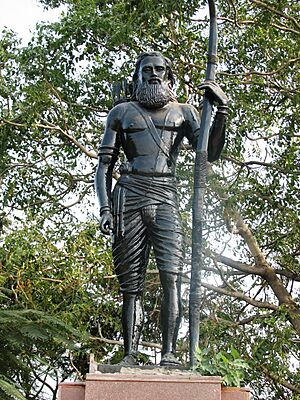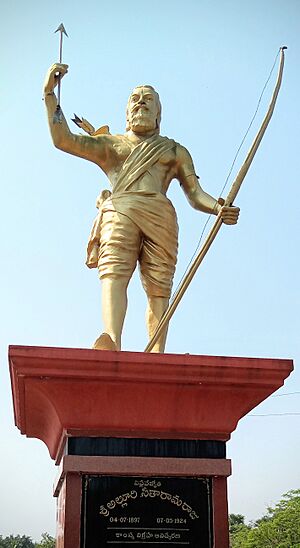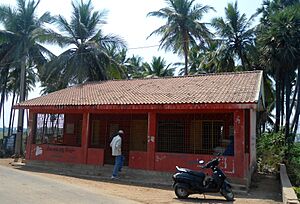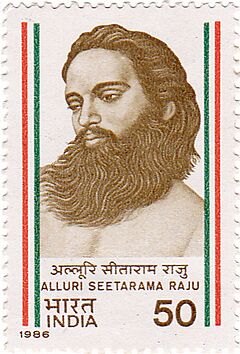Alluri Sitarama Raju facts for kids
Quick facts for kids
Alluri Sitarama Raju
|
|
|---|---|

Alluri's statue at the Tank Bund Road
|
|
| Born | 4 July 1897 or 1898 |
| Died | 7 May 1924 (aged 25 or 26) Koyyuru, Madras Presidency, British India
(present-day Andhra Pradesh, India) |
| Cause of death | Summary execution |
| Resting place | Krishnadevipeta, Andhra Pradesh, India |
| Known for | Rampa Rebellion of 1922 |
| Title | Manyam Veerudu |
Alluri Sitarama Raju (born July 4, 1897 or 1898 – died May 7, 1924) was an Indian freedom fighter. He led a rebellion against the British rule in India. He was born in what is now Andhra Pradesh.
Raju fought the British because of the 1882 Madras Forest Act. This law stopped adivasi (tribal) people from moving freely in their forest homes. It also prevented them from using their traditional farming method called 'podu'. This law threatened their way of life.
During the Non-cooperation movement (1920–1922), many people were unhappy with British rule. This led to the Rampa Rebellion (1922–1924). Alluri Sitarama Raju was the main leader of this uprising. He gathered tribal people and others who supported his cause. He fought the British using guerrilla tactics in the border areas of present-day Andhra Pradesh and Odisha. Local people called him "Manyam Veerudu," which means "Hero of the Jungle," because of his brave actions.
Alluri Sitarama Raju was born into a Telugu family. His birth name was Alluri Rama Raju. He added "Sita" to his name to remember a girl he loved who passed away young. He later became a sannyasa (a religious ascetic) at age 18. He grew into a strong leader for the tribal people who were struggling under colonial rule in the 20th century.
As the leader of the Manyam rebellion, Alluri Sitarama Raju led his forces against the British. His goal was to remove them from the Eastern Ghats region. During the rebellion, he often raided police stations. He did this to get weapons for his fighters, who did not have many. After each raid, he would leave a note. It was signed by him and told the police what he had taken. He even dared them to try and stop him.
Police stations in areas like Annavaram, Addateegala, Chintapalle, and Rampachodavaram were attacked. Many police officers were hurt or killed. The British spent nearly two years and a lot of money (over ₹4 million rupees) trying to catch him. In 1924, he was finally caught in Koyyuru village. He was tied to a tree and shot by a firing squad. A memorial with his remains is in Krishnadevipeta, Andhra Pradesh.
Contents
Early Life and Journey
Birth and Childhood
Alluri Sitarama Raju was born in the state of Andhra Pradesh, India. His father, Venkata Rama Raju, was a photographer. His mother, Surya Narayanamma, was a religious homemaker.
His exact birth date is debated. Some say it was July 4, 1897, others July 4, 1898. His birthplace also has different accounts. Some reports say Bhimavaram, others Mogallu. New information suggests Pandrangi is his true birthplace.
Venkata Rama Raju was a man who loved freedom. He taught his son to have self-respect. He once told young Rama Raju off for saluting Europeans, which was a common custom then. Venkata Rama Raju died when his son was eight years old.
Education and Youth
Rama Raju went to high school in Kakinada. There he became friends with Madduri Annapurnaiah, who also became a revolutionary. As a teenager, Rama Raju thought about becoming a Sannyasa (a religious ascetic).
At 15, he moved to Visakhapatnam for high school. He often visited distant areas and learned about the struggles of tribal people. Around this time, he became friends with a rich man. He developed a deep, non-romantic friendship with the friend's sister, Sita. When she died young, he was heartbroken. To honor her memory, he added her name to his. That is how he became known as Sita Rama Raju.
He left school without finishing. His uncle, Rama Krishnam Raju, then brought him to Narsapur. He enrolled him in Taylor High School. However, he eventually gave up formal education. He still learned a lot on his own. He became skilled in Telugu, Sanskrit, Hindi, and English. Even though he did not finish school, he was very interested in astrology, herbal medicine, and palmistry. He also learned to ride horses well. He became a sannyasi at 18.
Becoming a Leader
Even in high school, Rama Raju showed signs of being a leader. He often rode his uncle's horses to distant hilly places. He learned about the problems faced by different tribal groups under British rule. He was especially moved by the struggles of the Koyas, a hill tribe.
In 1921, he went on a pilgrimage. He visited Gangotri and Nashik, where the holy rivers Ganga and Godavari begin. During his travels, he met revolutionaries in Chittagong. He was shocked by the poor conditions of Indian people, especially the tribals. He decided to start a movement to free them from British rule. He then settled in the Papi hills near Godavari District, an area with many tribal people.
Sitarama Raju first became a Sadhu (holy man). He practiced spiritual ways to gain respect and power. He also became very good at healing people with herbs. He lived a simple life among the tribal people. He only took fruits and honey from them. He would return most of what they offered with his blessings. Soon, his kind nature made people believe he had special powers. They even saw him as a messiah. This belief grew stronger with stories he created and accepted about himself, including that he could not be defeated.
The hill tribes were innocent but strong people. They had to pay many fees for things like grazing cattle and collecting fruit. They were stopped from doing their traditional ‘Podu’ farming. Their whole way of life was in danger. Rama Raju saw their suffering. He asked British officials for help, but it did not work. He then felt that rebellion was the only way.
He began to organize and teach the tribal people about their rights. He prepared them to fight against the unfair rules of forest and tax officials, missionaries, and the police. He traveled through the forests. This helped him learn the land well, which later helped him in his guerrilla warfare plans.
Around this time, the British took away the ancestral lands of the Koya tribal brothers, Gam Malludora and Gam Gantamdora. Both were freedom fighters. They joined Rama Raju and became his trusted helpers. As British rule became too harsh, rebellion was the only choice for people to live freely. Rama Raju became their natural leader. The government tried to win him over. They offered him 60 acres of fertile land for his ashram. But he refused and stayed with his people.
Rampa Rebellion (1922–1924)
Causes of the Rebellion
The 1882 Madras Forest Act was passed to make money from wooded areas. This law stopped tribal people from moving freely in the forests. It prevented them from doing their traditional 'podu' farming. This farming method was their way of life. Without it, they faced starvation. Their only option was to work as coolies (laborers) for the government. This work was hard, demeaning, and unfair.
At the same time, the British also weakened the power of the muttadars. These were traditional leaders who collected taxes for the local kings. Now, they were just civil servants. They could not collect taxes as they used to. They also could not pass their position to their children. So, both the farmers and the tax collectors were unhappy with British rule.
Rama Raju used this unhappiness to gain support for his fight against the British. Most of his followers were from tribal communities. Some muttadars also joined him, especially those who cared about the greater good.
To get more support, Rama Raju used ideas from the Non-cooperation movement. He encouraged people to stop drinking alcohol and to wear Khadi (Indian-made cloth). He also told them to avoid British courts and use local panchayat courts instead. Even though the Non-cooperation movement ended in 1922, Rama Raju continued to spread its ideas among the hill people. He wanted to make them more aware of their rights and desire for change.
Because of his actions, the police watched him from February 1922. However, they did not realize he was planning an armed uprising. Rama Raju praised Gandhi sometimes. But he also told the Adivasis to get weapons and learn guerrilla warfare. He believed violence was needed to achieve swaraj (self-rule).
Fighting the British
Rama Raju and his supporters built strong groups of fighters. He got Khadi uniforms for all his troops. They used traditional weapons like bows, arrows, and spears. They used whistles and drums to send messages. At first, they had great success against the British.
Rama Raju knew that traditional weapons were not enough against modern firearms. So, he decided to take weapons from the enemy. He started attacking police stations.
Between August 22 and 24, 1922, Rama Raju led about 500 people. They raided police stations at Chintapalli, Krishnadevipeta, and Rajavomangi. He took many weapons, including muskets and rifles. He then traveled the area, getting more people to join. He even killed a police officer who was part of a group sent to find him. After each attack, Rama Raju would sign a note in the police station's diary. He would list what he took and dare the police to stop him.
Rama Raju told his followers not to attack any Indian soldiers, only the foreign enemy. His followers followed these orders carefully. When a mixed group of Indian and European soldiers moved through the mountains, his followers let the Indian soldiers pass. They only attacked the foreign troops.
The British struggled to catch Raju. The land was unfamiliar to them. Also, local people did not help the British. Instead, they helped Raju by giving him shelter and information. Official reports said that Raju's main group of rebels was small (80-100 people). But this number grew a lot when they attacked the British, as villagers joined in.
On September 23, more deaths occurred. Alluri ambushed a police group at Dammanapalli Ghat. He killed two officers. This made his reputation even stronger among the unhappy people. There were two more successful attacks against the police in September. The British then realized they needed to fight Raju's guerrilla tactics with similar methods. They brought in members from the Malabar Special Police, who were trained for such fighting.
The British tried to make local people stop supporting Rama Raju. They offered rewards and threatened punishment, but it did not work. Later, raids were carried out on police stations at Annavaram, Addateegala, Narsipatnam, and Rampachodavaram.
At Dharakonda, Raju was praying to Goddess Kali. A special police team attacked him but failed. This event made Raju seem even more powerful to the tribals. They began to see him as someone with divine powers.
Rama Raju was strongly supported by his assistant, Aggi Raju. His brave actions were seen as heroic. As the rebellion continued, the British brought in soldiers from the Assam Rifles to stop it. To end the rebellion and capture Alluri Sitarama Raju, the district collectors used harsh methods. They burned villages, destroyed crops, and killed cattle. But nothing worked.
The agency commissioner offered a reward of Rs 10,000 for Rama Raju. He offered Rs 1,000 each for his helpers Ghantam Dora and Mallam Dora. The fight lasted for about two years. It caught the attention of people and officials across the country. In April 1924, the British government sent T. G. Rutherford to stop the 'Manyam' uprising. He used extreme violence to find out where Raju and his followers were.
Rama Raju was getting support from the plains areas. So, the British blocked off the hills. This limited his influence to certain regions. Despite this, he tried to get more people to join him. He especially tried to get Congressmen from the plains. But they did not support him. They were against his actions because he did not follow Gandhi's idea of Nonviolence. Historian David Arnold said that the real reason Congress leaders did not support Raju was because they shared the same interests as the rich landowners and moneylenders. Raju and his people were fighting against these groups. Other political groups also did not support him.
Death and Legacy
After a huge effort for nearly two years, the British finally caught Alluri in the forests of Chintapalle. He was tied to a tree and shot on May 7, 1924, in the village of Koyyuru. A memorial with his remains is in Krishnadevipeta, near Visakhapatnam.
Raju's helper, Ghantam Dora, was killed on June 6, 1924. His brother Mallam Dora was caught and put in prison. After India became independent, Mallam Dora became an elected member of the Lok Sabha (Indian Parliament) in 1952.

Raju's efforts in fighting a powerful empire without state power were recognized. The British government admitted he was a skilled guerrilla warfare tactician. His rebellion lasted almost two years. It cost them over ₹4 million to defeat him.
In 1929, Mahatma Gandhi was given a picture of Rama Raju. Later, Gandhi wrote about him:
"Even though I do not support armed rebellion, I must respect a young man as brave, sacrificing, simple, and noble as young Shri Rama Raju... Raju was a great hero. I wish the youth of the country would have Shri Rama Raju’s daring, courage, and dedication. They should use these qualities to achieve self-rule through peaceful means. To me, it is becoming clearer every day that if we want to help the millions of people we have held back, there is no other way than through non-violence and truth. A nation of millions does not need any other way." — Mahatma Gandhi
Jawaharlal Nehru said that "Raju was one of those few heroes that could be counted on fingers." Netaji Subhas Chandra Bose noted that Alluri was very determined. His unmatched courage and sacrifice for people will ensure his place in history.

Historian David Arnold wrote that because of his name, tribal people saw Rama Raju as like the Hindu god "Rama". Raju was a religious man, but he never asked for this honor.
The independent Indian government released a postal stamp in his honor. It was released in Mogallu village, which is thought to be his birthplace. The Government of Andhra Pradesh built memorials where he lived. They also gave a pension to his surviving brother. In 2022, the Government of Andhra Pradesh created a new district named Alluri Sitarama Raju district. Its headquarters is Paderu.
See also
- Revolutionary movement for Indian independence



